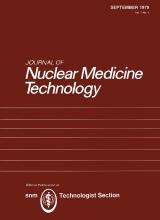Abstract
In attempting to add the important parameter of exercise to routine radionuclide-ventriculogram studies, motion becomes an important technical consideration. We identified four problems. They were solved by the development, selection and utilization of particular equipment and techniques. Our tests were conducted using a line source taped to a subject’s chest. Profiles of the line-source data and subsequent graphs were developed to demonstrate the effects of motion reducing techniques.







